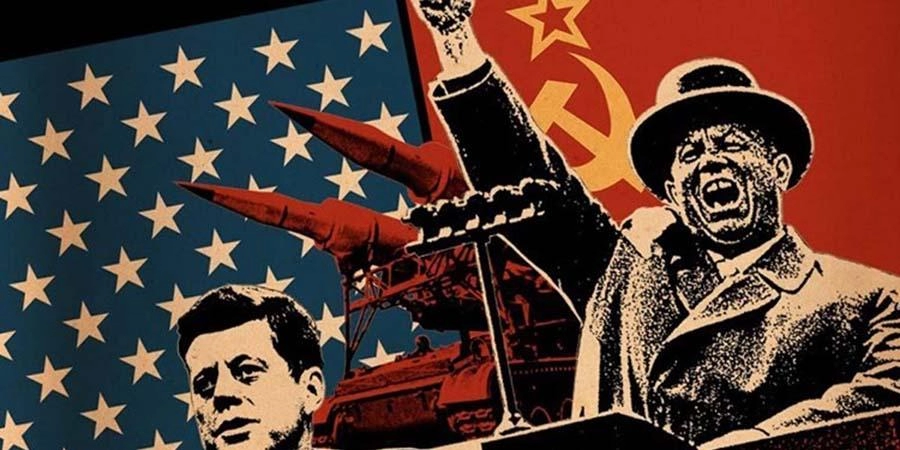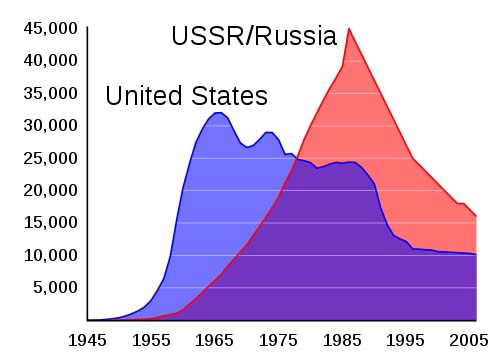The Cold War
What was the Cold War? Many of us who were born during it, raised during it, and have retired during it cannot provide an unequivocal answer. From 1945 until 1991, most peoples of the Earth lived in a world divided by the competition between two so-called superpowers, the United States and the Union of Soviet Socialist Republics.
Expenditures by the US government for defense alone during this period are estimated at around $8 trillion. The economic and social costs to the citizens of the Soviet Union were much greater, even, because so much more of that nation’s gross domestic product (GDP) was expended to maintain parity and viability.

First-, Second-, and Third-World nations(1) allied themselves in a variety of often confusing and overlapping defense and economic treaties. Other nations remained determinedly non-aligned, and so became known as the Non-Aligned States, essentially becoming an alliance of the non-allied.
Wars were fought and millions lost their lives, homes, and livelihoods. Conflicts between nations sponsored or supported by the US, the USSR, and the Peoples Republic of China occurred in, among other areas:
- Greece
- The Caribbean (Cuba, Dominican Republic, Granada)
- Africa (Angola, The Congo, Namibia)
- Palestine
- Korea
- Eastern Europe (Hungary, Czechoslovakia)
- Southeast Asia (Malaya, Vietnam, Laos, Cambodia)
- Central America (Honduras, El Salvador, Nicaragua)
- South America (Bolivia, Peru, Chile, Columbia)
- Afghanistan
What Kind of War?
Merriam-Webster has two main definitions for “war:”
- A state of usually open and declared armed hostile conflict between states or nations
- A state of hostility, conflict, or antagonism; a struggle or competition between opposing forces or for a particular end
At no time did the US and the USSR formally declare the other a belligerent in a state of armed conflict. However, both engaged in combat against each other through other nations, known variously as proxy- or client-states for their affiliation with one or the other of the superpowers. So, although it’s a bit murky, it is clear that the first definition applies.
The applicability of the second definition is much clearer and more easily accepted. Many accept it because they cast the conflict as one between two completely opposing economic forms, capitalism and communism. Accordingly, neither capitalism nor communism would survive in a world where the other existed, too, so the conflict was both inevitable and unresolvable.
Nuances
Politics, philosophy, economics—every aspect of human intellectual existence is heavily nuanced. Why? Because no one has an idea that cannot be mucked up by someone else. For example:
Marxism
Neither Marx nor Engels were dead before others began reinterpreting for them their own theories of communism, class struggle, the historical dialectic, and political economy. In our time, Marxism has been supplanted regionally by:
- Marxism-Leninism (really, Leninism)
- Trotskyism
- Stalinism
- Maoism
- Eurocommunism
- Hoxhaism
- Western Marxism
- Structural Marxism
- Neo-Marxism
- Cultural Marxism
- Analytical Marxism
- Marxist Humanism
- Marxist Theology
Repackaging Christian theology in Marxist terms as “liberation theology” is particularly ironic, given Marx’s often ill-quoted analysis of religion.
Capitalism
There is no single author of capitalist theory; there are thousands who have written about the private ownership of production and the public trading of labor, goods, and capital. There are, of course, many, many supplemental concepts of capitalism, including:
- Anarcho-capitalism
- Corporate capitalism
- Crony capitalism
- Finance capitalism
- Laissez-faire capitalism
- Technocapitalism
- Neo-Capitalism
- Late capitalism
- Post-capitalism
- State capitalism
- State monopoly capitalism
There are more schisms and sects involved with these economic theories than in any of the theologies or churches in our world.
The Cold War was as nuanced as the two economic theories whose major proponents prosecuted it. Thus, the US often supported countries whose governments were decidedly non-democratic to resist communist-inspired or led rebellions. The USSR often supported states for whom communism was anathema, such as the Muslim nations in the Middle East, in order to oppose other nations supported by the US.
Intellectual & Operational Origins of the Conflict
Who moved first? And, why? The historical timeline shows increasing Soviet aggressive diplomacy and supra-diplomacy beginning in the later stages of the European campaign ending the Second World War. There is little doubt that Stalin kept the Red Army idle while the German Wehrmacht eliminated the Polish rebellion in Warsaw in 1944, and that the Soviet Communist Party did everything possible to set up indigenous communist parties in the Eastern European states—Romania, Hungary, Poland, Yugoslavia, Albania, & Czechoslovakia— as the Red Army wrested them from Nazi Germany.
By 1954, the political map of the world included communist states in Eastern Europe and politically-divided nations in Germany, Korea, and Vietnam. Additionally, the Soviet Union had established the Warsaw Pact (to counter NATO), provided arms and materiel to Arab states fighting the new state of Israel, and had at least permitted the North Koreans to launch an invasion of South Korea and plunge that isthmus into war.
The United States stepped into the political vacuum left by Great Britain and France after World War II and implemented what became know as the Truman Doctrine to support Greece against a Soviet-inspired and supported rebellion and contain Soviet expansion(2). The US also joined NATO(3) and involved itself in Southeast Asia and the Pacific rim to a far greater degree than in its history.
Aggression or Defense?
In the eyes of Soviet Russian leaders, excluding Stalin, the actions of the USSR immediately after the Second World War were seen as defensive. Western Europeans and US leaders saw the same activities as dangerously aggressive and bellicose. How could these be reconciled?
Soviet leaders saw their actions from the end of World War II onward as defense against their encirclement by capitalist countries. In their view, famously described by George F. Keenan in his “Long Telegram:”
…[the] USSR still lives in antagonistic “capitalist encirclement” with which in the long run there can be no permanent peaceful coexistence.
The US and its western allies, on the other hand, came to see Soviet actions as aggression. Soviet rhetoric caused many to believe that the Soviet leadership saw capitalist countries as belligerents in a constant economic struggle, or class war.
Soviet leaders interpreted western counters to their actions as aggression. In this, they included programs such as the Marshall Plan and later treaties, such as NATO.
US defense efforts to identify Soviet military expansion, such as the CIA-sponsored high-altitude photo-reconnaissance flights by U2 aircraft were, quite naturally, seen by the Soviets as aggression.
The 1962 Cuban Missile Crisis resulted from Soviet Premier Krushchev’s attempt to present a credible strategic threat on the cheap, since the USSR did not have the ability then to counter the number of US weapons, and their world-wide location, arrayed against the Soviet Union. In the 1980s, the Soviet government deployed Delta-class ballistic missile submarines in the central Atlantic Ocean to demonstrate its concern over US theater nuclear missile deployments in NATO. The reason: the USSR could not reach US targets with theater nuclear missiles, which are harder to detect.
The Soviet attempt to defend against increased US strategic nuclear missile capabilities by positioning medium-range nuclear missiles in Cuba was recognized as aggression by President Kennedy and the US government. (Despite Kennedy’s claim in the 1960 election campaign of a “missile gap” favoring the Soviet Union, the US held a distinct advantage at the time in numbers of missiles and warheads.)
Of course, the US response to Soviet missiles in Cuba was seen by the Soviets as aggression. After all, the US declared an embargo specifically targeted against Soviet shipping, conducted reconnaissance overflights of Cuban airspace, dispersed and deployed Strategic Air Command wings, and deployed troops to ports of embarkation, as if to invade their ally, Cuba.
What one sees as aggression, the other guy claims is defense.
 US-USSR nuclear stockpile
US-USSR nuclear stockpileThe Russian View
Germany invaded Russia twice in the 20th century, in 1915 and 1941. Although the 1915 invasion resulted from Imperial Russia’s invasion of East Prussia in 1914, the cataclysmic results of both invasions, and especially as the second followed the first so closely, could not be ignored. Soviet Russia was determined to create a buffer on its peripheries that would allow it to meet and defeat another invasion before the invader entered the Soviet Union.
In 1918, Lenin prevailed upon Trotsky to sign the Treaty of Brest-Litovsk for Russia, ending its participation in the First World War. (Russia ceded Belarus, Poland, Latvia, Lithuania, Estonia, and Finland to German suzerainty.) Why? Because a true communist believes that communism is destined to triumph ultimately, regardless of any temporary setback.
Temporary Setback: Germany’s capitulation to the Allies in November, 1918 rendered moot the Treaty.
Stalin had a somewhat different take on this process. After all, if communism would triumph, why not help it along? And, what more help could be provided than by having the NKVD (Peoples Commissariat for Internal Affairs, the former KGB, or Committee for State Security) eliminate indigenous non-communists while ensuring that local communist party leadership hewed the Soviet Communist line?
Franklin D. Roosevelt and Winston Churchill agreed at the Yalta conference to Stalin’s determination to keep Polish territories seized under the Molotov-Ribbentrop Pact of 1939 between the USSR and Nazi Germany. The Allies decided to “compensate” Poland by giving it East Prussia and German Silesia.
Thus, pursuing what the Soviets believed to be the defense of their homeland and of communism, they created client states in Eastern Europe, attempted to force Turkey to grant it perpetual right of navigation through the Bosporus into the Mediterranean Sea, and supported conflict elsewhere that would, hopefully, distract the capitalist countries from concentrating against the USSR.(4)
The Western View
Great Britain and the US understood that the Soviet’s agreement at the Yalta conference to free elections in countries formerly occupied by Nazi Germany was, at best, tenuous. For one, there were no provisions to guarantee such elections. Also, the western Allies were frustrated by Stalin over the Provisional Government the Soviets had already established in Poland.
Harry Truman, who was not a party to diplomatic policy decisions while FDR lived, adamantly supported elections and felt a greater sense of disappointment and betrayal than did Churchill when Stalin did not comply. The actions of the Soviets in their support for the communist insurgents in the Greek civil war and Stalin’s demand of Turkey for partial control of the Dardanelles convinced Truman that the US needed to more actively oppose communism world-wide, and he declared the Truman Doctrine in a speech to Congress on March 12, 1947.
Containment
George F. Keenan provided the intellectual underpinning for the Truman Doctrine, along with Winston Churchill’s “Iron Curtain” speech (Fulton, MS, March 5, 1946). Truman used these analyses and recommendations as the basis for his Doctrine. Subsequent Presidents, notably Lyndon B. Johnson, used the Truman Doctrine to justify US intervention in, for example, Southeast Asia.
In February, 1946, Keenan wrote what is known as the “Long Telegram” in response to a US Department of Treasury inquiry concerning Soviet resistance to the International Monetary Fund and the World Bank. In July, 1946, Clark Clifford and George Elsey prepared a report for Secretary of Defense Forrestal and, ultimately, President Truman in which they recommended an overall approach to Soviet policy based on the Long Telegram.
Keenan wrote another analysis, taking into account his earlier Long Telegram and the Clifford-Elsey Report. In July, 1947, Foreign Affairs published this paper, “The Sources of Soviet Conduct,” under the pseudonym “X;” Keenan included this famous recommendation:
In these circumstances it is clear that the main element of any United States policy toward the Soviet Union must be that of long-term, patient but firm and vigilant containment of Russian expansive tendencies.
Another observation of Keenan’s probably had greater influence on President Ronald Reagan than most have noted, or wish to note. Consider the economic state of the Soviet Union and its attempts to counter US and western initiatives in the early 1990s when you read this:
But the United States has it in its power to increase enormously the strains under which Soviet policy must operate, to force upon the Kremlin a far greater degree of moderation and circumspection than it has had to observe in recent years, and in this way to promote tendencies which must eventually find their outlet in either the breakup or the gradual mellowing of Soviet power.
But Wait a Minute…
In 1996, when Keenan was interviewed by David Gergen on PBS, he insisted that his recommendation had been consistently misinterpreted and misapplied in US foreign policy:
…It all came down to one sentence in the “X” Article where I said that wherever these people, meaning the Soviet leadership, confronted us with dangerous hostility anywhere in the world, we should do everything possible to contain it and not let them expand any further. I should have explained that I didn’t suspect them of any desire to launch an attack on us. This was right after the war, and it was absurd to suppose that they were going to turn around and attack the United States.
The Costs of the Cold War
- The United States spent at least an estimated $8 trillion on its military during the Cold War. More importantly, over 100,000 US citizens lost their lives in combat, principally in Korea and South Vietnam, during this undeclared war.
- I cannot find an estimate—or a guesstimate—of the costs expended by the Soviet Union that are directly attributable to the Cold War. Over 14,000 Soviet troops lost their lives in Afghanistan and another 54,000 were casualties.
- Additional personnel lost due to “incidents” such as the Soviet shootdown of a USAF C-130 in 1958 and the North Korean seizure of USS PUEBLO in 1968 and shootdown of the BEGGAR HAWK mission in 1969.
- But, many more non-US and non-USSR citizens lost their lives or were wounded in wars on the peripheries of the Cold War. Such as the conflicts in Laos, Cambodia, Vietnam, Korea, Africa, the Middle East, Central and South America, and Cuba.
At least twice—in 1962 and 1983—the world came close to nuclear war.
 1960s Family Fallout Shelter
1960s Family Fallout ShelterAnd For What?
I served quite a while on active duty in the US Navy during the Cold War. I was, and remain, proud of my service to my country and of those with whom I worked. I was, and remain, proud of my country and its history and achievements.
That doesn’t mean, though, that I can’t ask: What did this accomplish?
- The Russian Federation and the US have thousands of multiple, independently-targetable nuclear warheads maintained by thousands of personnel in strategic missile, air force, and naval units
- The nuclear weapons “club” includes Great Britain, France, Israel, India, and Pakistan
- North Korea and Iran are applicants to this club, too
- The Russian Federation and the US are worried about their stockpiles of strategic and theater nuclear weapons
- The Russian Federation and the US face huge expenditures to clean up nuclear-related sites, including power plants (such as the continuing effort at Chernobyl in the Ukraine) and weapons facilities (such as at Hanford, Washington)
- The Russian Federation and the US are major trade partners today; during the Cold war, trade existed on a much smaller scale and was much more tightly regulated
- Eastern European countries have open economies and free elections
- The Warsaw Pact was disbanded
- NATO remains, but its future is ambivalent, at best, and may be an anachronism
- Cuba remains a Communist-led country & its major trading partner is the Russian Federation
- Several Muslim republics in the former Soviet Far East are independent states
- Georgia is an independent state, although partitioned
Competitors
The struggle between the Soviet Union and the US was about the competition between rival economies.
Political Philosophy or Ideology
I know, some will assert that there was the primary issue concerned individual freedom v. totalitarianism. That’s valid, even though (again) nuanced. (Does the individual in a capitalist economy have complete freedom? Check out any of Ayn Rand’s books…)
- Stalin was a dictator and a murderer. At his direction, his government murdered millions of its citizens before the Nazis invaded and killed millions more.
- I don’t believe that Stalin was a communist, despite his membership in the Communist Party of the Soviet Union. He certainly wasn’t in the Classic Marxist school, and his antipathy toward Marxism-Leninism and Trotskyism is demonstrated by his murder of Lenin and Trotsky.
- Subsequent leaders of the CPSU and the USSR were often hard-liners, some more than others (Andropov, for example), but none were, tried to be, or could be, another Stalin.
- Soviet communism was, as Lenin described it, a national communism and, therefore, much different from the communism described by Marx and Engels.
- The Soviet Communist Party held that it represented the workers and their interests over that of the bourgeoisie, which class the Party eliminated (or, liquidated).
- The result was massive central planning (the ultimate worker’s commune) and leadership by diktat.
- There were aspects of capitalism, of course, in the sale of foodstuffs and consumerism, in that citizens could shop in the government-owned stores.
The expense involved in seeking such a contract and then, if awarded, producing it in the limited numbers specified so that the project is profitable affects the number of companies that can pursue such projects.
Consider the number of aircraft manufacturers in 1940 and the number present today:
| 1940 | Bell, Boeing, Consolidated, Convair, Curtiss, Grumman, Hughes, Lockheed, Martin, North American, Northrop |
| 2009 | Boeing, Lockheed-Martin, Northrop-Grumman |
There were other aspects of capitalism, too. For instance, the higher one ascended in the hierarchy, the greater the perks.
- In the US, capitalism has not been unregulated or not subject to any form of central planning for quite a while, and with good reason. The concept of private property is set in our Constitution, although some complain (bitterly) that our laws allow government to tax private property, thereby making it less private.
- Companies are subject to government regulation, although this is mitigated by the political administration in office at any given time
- We occasionally forget that private enterprise—capitalism—does not concern itself with the greater good.
- Labor, goods, and capital move within and between markets regularly and irregularly, even though regulated.
- Although the US does not exercise formal central planning over the economy, its activities exert such influence over significant areas of the economy that there is de facto central planning
- For example, government orders for military equipment and materiel carry with them reams of instructions, guidelines, and regulation.
- Since the acquisition of a contract to produce a military aircraft is so potentially lucrative, the manufacturers dedicate their resources to that effort.
- This reduces the capability to produce aircraft for commercial accounts, and subjects their staff and workers to government oversight, particularly regarding personnel security.
The Answer: Economics
By The Way…The fact is, that the People’s Republic of China is, or shortly will be, the major economic engine in our political world.(5)
Democracies face, or face down, dictators every day without resorting to policies pursued during the Cold War. US Presidents have dealt with this, from Adolf Hitler and Benito Mussolini to Castro and Noriega.
The Cold War, on the other hand, pit one the economy of one society against that of another. Because of that, the reach of conflict was much deeper and emotional because the social order of each society was inextricably linked to its economic order.
Witness the disruptions and social chaos that accompanied the economic changes in the Russian Federation after the dissolution of the Soviet Union.
This is not a Soviet or communist phenomena, though. Today, the US is embroiled in a similar social, political, and economic convulsion for which the primary symptom is (ready?):
Health insurance reform!
Notes
(2) "The Truman Doctrine was an American foreign policy whose stated purpose was to counter Soviet geopolitical expansion during the Cold War. It was first announced to Congress by President Harry S. Truman on March 12, 1947 and further developed on July 12, 1948 when he pledged to contain threats to Greece and Turkey. Direct American military force was usually not involved, but Congress appropriated financial aid to support Greece and Turkey. More generally, the Truman Doctrine implied American support for other nations allegedly threatened by Soviet communism. The Truman Doctrine became the foundation of American foreign policy, and led, in 1949, to the formation of NATO, a military alliance that is still in effect." [Read more].
(4) Stalin’s goal, most probably, was to concentrate ever more power to himself.
This is Not a Scholarly Article! That is, the article presents my conclusions and opinions, backed by references I have chosen, so it resembles a history. However, I did not write it for a scholarly audience in scholarly jargon or submit it to a scholarly peer review.
I do not seek to justify or denigrate the actions taken during the Cold War. I document them and comment upon them, but this is far too complex an issue to be dealt with in one article.
You are welcome—encouraged—to review and comment on the article, of course. Whether or not I rise to the status of your peer is another matter.
